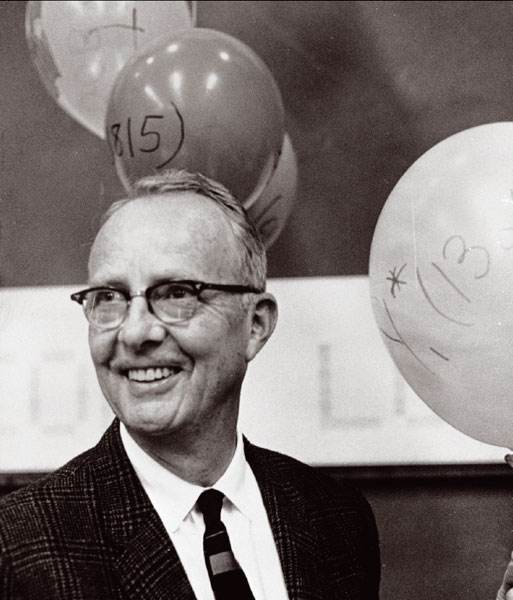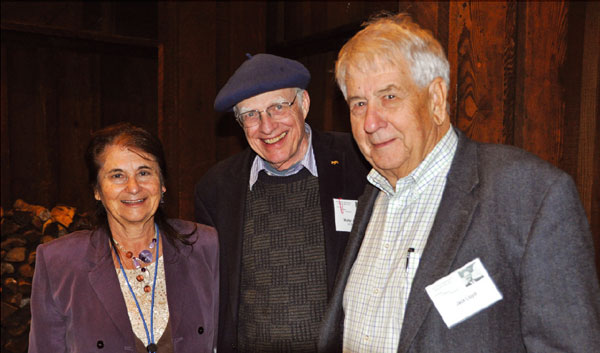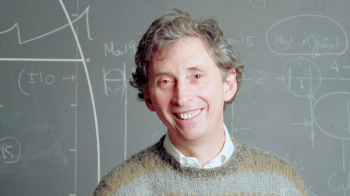Recollecting the work of a great scientist and inventor.

Luis Alvarez – one of the greatest experimental physicists of the 20th century – combined the interests of a scientist, an inventor, a detective and an explorer. He left his mark on areas that ranged from radar through to cosmic rays, nuclear physics, particle accelerators, detectors and large-scale data analysis, as well as particles and astrophysics. On 19 November, some 200 people gathered at Berkeley to commemorate the 100th anniversary of his birth. Alumni of the Alvarez group – among them physicists, engineers, programmers and bubble-chamber film scanners – were joined by his collaborators, family, present-day students and admirers, as well as scientists whose professional lineage traces back to him. Hosted by the Lawrence Berkeley National Laboratory (LBNL) and the University of California at Berkeley, the symposium reviewed his long career and lasting legacy.
A recurring theme of the symposium was, as one speaker put it, a “Shakespeare-type dilemma”: how could one person have accomplished all of that in one lifetime?
Beyond his own initiatives, Alvarez created a culture around him that inspired others to, as George Smoot put it, “think big,” as well as to “think broadly and then deep” and to take risks. Combined with Alvarez’s strong scientific standards and great care in executing them, these principles led directly to the awarding of two Nobel prizes in physics to scientists at Berkeley – George Smoot in 2006 and Saul Perlmutter in 2011 – in addition to Alvarez’s own Nobel prize in 1968.
Invaluable talents
Rich Muller, who was Alvarez’s last graduate student, described some of his mentor’s work during the Second World War. Alvarez’s talents as an inventor made him invaluable to the war effort. Among his contributions was the ground-controlled approach (GCA) that allowed planes to land at night and in poor visibility. For the rest of his life, at least once a year, Alvarez would bump into someone who thanked him for GCA, explaining: “I was a pilot in the Second World War and you saved my life.” In 1948, when the Soviets imposed a blockade of Berlin, GCA allowed the Berlin Airlift to succeed by assuring the cargo planes’ safe landing in difficult circumstances.
In the early post-war period, Alvarez’s inventions included the proton linear accelerator (with Wolfgang Panofsky) and a tandem Van de Graaff accelerator. Over his lifetime he was granted more than 40 US patents. He applied for his first in 1943 and his last in 1988, the year he died. He was one of the first inductees to the Inventor’s Hall of Fame. He loved thinking and, heeding the advice of his physiologist father, frequently made time to sit and think. Muller recalled that Alvarez told him that only one idea in 10 is worth pursuing, and only one in 100 might lead to a discovery. Considering how many of his ideas bore remarkable fruit, Muller concluded that Alvarez must have had thousands of them.
One such idea originated from his interactions in 1953 with Don Glaser, who invented the bubble chamber. Alvarez thought that a large liquid-hydrogen bubble chamber was needed to solve all of the puzzles generated by the many particles that had been recently discovered. He immediately put his two graduate students, Frank Crawford and Lynn Stevenson, and a number of his technicians to work on the project. The first tracks in a hydrogen bubble chamber were seen in the summer of 1954.
A succession of chambers then culminated in the 72-inch bubble chamber, which began operating in 1959. Jack Lloyd, an engineer in the Alvarez group at the time, believes that it was probably one of the largest tanks of liquid hydrogen ever made (400 l), interfaced with the most enormous piece of optical glass ever made. As Lloyd recalled: “It had to work at around 60 or 70 psi and it pulsed every 6 s, with about a 10 psi pulse, which is a frightening thing to an engineer because of potential fatigue problems.”
Observation of the traces left by particles in the bubble chamber needed additional equipment for scanning the photographs and measuring the tracks. In the end, it was necessary to use computers to handle the wealth of information coming from the measurements. The latter task was assigned to Art Rosenfeld, who came to the Alvarez group as a post-doc on the recommendation of Enrico Fermi. Fermi said that, given the politics of the two men, they would be on speaking terms about 80% of the time. “That was right,” Rosenfeld recalled. Keeping the peace was not among Alvarez’s strengths.
By 1967 the Alvarez group was analysing more than a million events a year. An army of scanners examined the films for events of interest and a battalion of computer programmers wrote code to analyse them. The bubble-chamber team was at that time the largest high-energy physics group in the world, totalling several hundred people. The development of the chamber and the analysis systems resulted in an explosion of new particle discoveries that helped to establish the quark model. It was this work that earned Alvarez the Nobel Prize in Physics in 1968.
Among his other attention-grabbing ideas was the use of cosmic rays to search for secret chambers in Chephren’s pyramid in Giza. Jerry Anderson, who collaborated on the project in the late 1960s, told of Alvarez’s work in assembling a team of Egyptian and US scientists to design and carry out the experiment. After pointing detectors in several different directions they found no evidence of any voids in the solid pyramid. Afterwards, if anyone commented that the team had not found any hidden chambers, Alvarez would respond, “We found that there were no hidden chambers” – an important distinction.
Around that same time he became interested in a film taken with a home-movie camera that captured the assassination of President John F Kennedy. Charles Wohl, a student in his group, described Alvarez’s careful analysis of the film and his conclusions, which clarified some of the uncertainties in the official investigation of the assassination.
The Alvarez philosophy
More than one speaker quoted this passage from Alvarez’s autobiography: “I’m convinced that a controlled disrespect for authority is essential to a scientist. All of the good experimental physicists I have known have had an intense curiosity that no ‘Keep Out’ sign could mute.” Yet, Alvarez had a perfect safety record while building and operating the huge bubble chamber. Stanley Wojcicki, who was a graduate student in the group, said that when Alvarez was retiring as the head of the bubble-chamber group and a new head was about to be appointed, someone asked him about the replacement’s responsibilities. “He’s the person who talks to the widows after an accident,” was Alvarez’s response.

Saul Perlmutter, who was Muller’s graduate student, felt Alvarez’s influence keenly when he came to LBNL in 1982. He characterized it as a “can-do, cowboy spirit”. He explained: “As a physicist, you had the hunting licence to look at any problem whatsoever and also you had the arrogance to think you were going to be able to solve that problem – or at least be able to make a measurement that might be relevant to the problem. And if there was equipment around, you would use it; and if there was not equipment around, you would invent it. And you had the wealth of talent around you, of the engineers, mechanical and electrical, who knew how to put these things together and how to make them work.” That was fertile ground for discovery.
Perlmutter also benefited from Alvarez’s philosophy in another way. When he and Carl Pennypacker wanted to start looking for supernovae at greater distances, Muller was sceptical about their prospects for success. However, he had learnt from Alvarez that part of the job of a group leader is to support people in trying things even if you are not sure that they are the right things to do. This is what he did – and Perlmutter’s Nobel prize for that work attests to Muller’s (and Alvarez’s) wisdom.

In the final decade of his life, Alvarez’s “hunting licence” led him into geology and palaeontology. His son, Walter Alvarez, a geologist studying the Cretaceous-Tertiary boundary in an outcropping in Italy, gave his father a rock showing the clay boundary separating a layer of limestone with abundant fossils of diverse species and a layer largely devoid of signs of life. Luis was intrigued and eventually conceived of a way of determining how long it took for this clay layer to accumulate. This would signal whether the mass extinction was sudden or gradual. Neutron activation analysis showed an anomalous abundance of iridium in the clay layer, a result that led eventually to the Alvarez’s theory that an impact from a comet or asteroid caused the dinosaurs and other species to die out. The announcement stirred a controversy that was only recently settled in their favour.
Other speakers during the day attested to Luis Alvarez’s inventive spirit and his fearlessness in asking original and important questions in far-flung fields in which he had no previous experience. He eagerly embraced new ideas and unhesitatingly took on new challenges throughout his career. The lively and enlightening day ended with a reception and dinner, where more family members and colleagues related their recollections of this icon of 20th-century science and technology.








